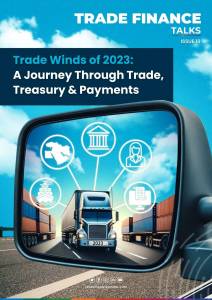Estimated reading time: 8 minutes
With approximately 80% of global trade documents governed by English law, the enactment of the Electronic Trade Documents Act (ETDA) marks a significant stride towards revolutionising international trade through digitalisation.
The ETDA grants legal recognition to electronic trade documents under English law, including electronic bills of lading, which came into force on 20 September 2023.
The Act ushers in a new era of trade, one that is characterised by enhanced efficiency, inclusivity, and sustainability, ideally in sync with our digital age.
Yet, the implementation of the ETDA is merely the initial step in the journey towards digital international trade as the transformation is anticipated to present a host of new challenges for businesses.
Stakeholders across various industries will need to embrace emerging technologies and adapt their operations to effectively thrive in this digital era.
In response to this monumental shift is a strategic collaboration between data technology firm, Enigio, and Lloyds Bank.
This long-term partnership is set to propel Lloyds Bank into the digital frontier of trade finance documentation, promising clients faster, more cost-efficient, flexible, and secure solutions powered by blockchain technology.
At Sibos Toronto, TFG’s Deepesh Patel spoke with Rogier van Lammeren, Managing Director, Head of Trade & Working Capital Products at Lloyds Bank, and Patrik Zekkar, CEO of Enigio.
Together, they discussed the recent developments of their partnership, the game-changing role of technology in trade, and the hurdles anticipated in transitioning to the digital space, particularly with the ETDA now fully in force.

Fostering innovation through collaboration: The Lloyds Bank and Enigio partnership
Lloyds Bank has taken a substantial milestone towards revolutionising the digital transformation of trade finance documentation. van Lammeren revealed the bank’s €3 million investment in Enigio, which aims to accelerate the pace of digitisation in the trade finance sector. van Lammeren said, “This morning we were really pleased to announce that Lloyds Bank has made an investment into Enigio.”
This strategic alliance not only showcases Lloyds Banks’ commitment to driving technological innovation but also positions Enigio for further expansion.
Notably, the significance of this investment lies in its potential to provide businesses with a faster, more cost-effective, and highly secure method for digitising vital physical documents, such as promissory notes, bills of exchange, and bills of lading.
Asserting the role collaboration plays in driving innovation, van Lammeren said, “It’s not just down to us. We need the rest of industry, all the banks, Swift, the freight companies, and everyone else to join our efforts to allow the digitalisation of trade globally.”
This partnership builds on a longstanding teamwork established over four years, where Lloyds Bank and Enigio have worked together to enhance the digitalisation of trade.
Zekkar echoed the collaborative sentiment, and said, “We started a cooperation or partnership with Lloyds in 2019. There’s been a lot of testing development scope requirements in order to enhance the solution.”
Zekkar also notes the importance of the trade community coming together, saying, “Trade is by nature collaboration, it’s interdependencies, and especially if we’re going to do a cross-industry change, this will be critical that we get moving. All of us.”
Moreover, through the alliance, Lloyds Bank and Enigio are set to expand Enigio’s bespoke solution, trace:original. The solution removes the need to physically transfer paper documents within trade transactions.
Together, they are also exploring avenues to incorporate trace: original documents into broader trade finance products, including documentary collections and credits. With only 1% of the 4 billion trade documents in daily transit currently digitised, Enigio’s solution offers a transformative approach to a traditionally paper-intensive process.

Transforming trade: The impact of the Electronic Trade Documents Act (ETDA)
In a historic move towards digitalising trade documents, the ETDA received royal assent on 20 July 2023. This landmark legislation, which entered into force on 20 September 2023, will legally recognise the use of electronic trade documents, signifying a transformational moment for the global trade community.
Prior to the ETDA, electronic trade documents lacked the same legal rights as their paper-based counterparts under English law.
Speaking on the far-reaching impact of this legislative breakthrough, van Lammeren remarked, “The ICC United Kingdom has estimated that the Electronic Trade Documents Act will enable €25 billion of incremental SME export growth, but it will also reduce costs drastically. You can imagine taking the paper out, and putting it into a digital format will reduce trade costs by up to 80%.”
Highlighting the pioneering efforts of Lloyds Bank and Enigio in the digital space, he added, “Together with Enigio, we launched the first digital version of a promissory note back in 2022, a real first for the industry. And we’ve done a number of these transactions since. They are digital trade transactions, pre-law change, so they exist outside of the new ETDA. But it’s really helped us to test how to digitalise trade and identify what the benefits are for all companies involved.”
Building on van Lammeren’s insights, Zekkar pointed out the multifaceted opportunities the ETDA offers, extending beyond speed and cost savings. “The structured data layer is a data container carrying the golden source of data. And when the documents are born digital and kept digital, there are huge possibilities to leverage that data in processes, automation, and also in risk assessments,” he explained.
Furthermore, van Lammeren stressed the importance of standards in the journey of digital transformation. Organisations like Swift play a vital part in standardising the trade infrastructure, uniting banks and participants in a collaborative industry shift.
“Through Swift, we’re leaning on all the banks and all the other Swift participants to join in the digitalisation of trade and interoperability efforts across all the industry platforms. We see Swift play a really important role in that,” he affirmed.

Addressing risks in the digitalisation of trade documents: A threefold perspective
Embarking on a holistic digital transformation undoubtedly brings forth its own set of distinctive challenges. Zekkar shed light on a number of obstacles, outlining three key areas of concern in adopting the ETDA.
Firstly, he recognised the absence of established legal precedents due to the novelty of the legislation. In light of this, he underscored the indispensable role of collaboration between technology providers and legal professionals not only to meet the functional requirements but also to define the ‘how’ of implementation.
“That is where technology meets legal. The ‘how’ is tech and the interpretation must be done by lawyers,” he noted.
The second challenge, he pointed out, lies in ensuring interoperability between technical providers. Zekkar noted that without this critical element, the full potential of digitalisation would remain untapped, potentially resulting in fragmentation within the system.
Zekkar stated, “There’s still fragmentation. We are working together with Lloyds and ICC United Kingdom to prove that we have a standard interoperability protocol developed which will soon be released together with another document platform provider.”
Lastly, he highlighted the importance of awareness as a third significant consideration. He asserted, “It’s about awareness. Government institutions and public authorities have a huge responsibility. Still, the industry also has a responsibility to roll out awareness to the larger ecosystem that this is here, this is the benefit, this is how you do it.’’
Charting progress: From legislation to implementation in digital trade
As the partnership between Lloyds Bank and Enigio continues to flourish, the question arises: how do both parties measure success?
For Lloyds Bank, van Lammeren put forth 3 key metrics that the bank would focus on.
- The number of digital transactions after the implementation of the ETDA.
- Client feedback on the process of these transactions.
- Looking at prospective exporters, and providing them the same advantages as well-established traders.
On the last point, van Lammeren said, “We really believe that these changes should stand to benefit prospective exporters as much as existing exporters.’’
For Enigio, on the other hand, Zekkar emphasised the importance of widespread adoption. The opportunity to bring all stakeholders in a trade transaction together, including carriers, freight forwarders, port authorities, banks, and exporters/importers, is immense.
Besides, he referenced geographical adoption, leveraging the UK legislation, saying, “Adoption is important geographically too, I think we can leverage the UK legislation much more than I think people are aware of.’’
The transition towards a fully standardised, interoperable digital trade future is underway, and it is through such strategic partnerships that technology and trade can unite to drive it forward.










































